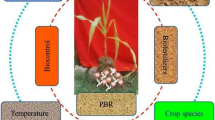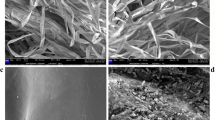Abstract
Microorganisms can promote plant growth by increasing phytomass production, nutrient uptake, photosynthesis rates, and grain yield, which can result in higher profits for farmers. However, there is limited information available about the physiological characteristics of lowland rice after treatment with beneficial microorganisms in the tropical region. This study aimed to determine the effects of different beneficial microorganisms and various application forms on phytomass production, gas exchange, and nutrient contents in the lowland rice cultivar ‘BRS Catiana’ in a tropical region. The experiment was performed under greenhouse conditions utilizing a completely randomized design and a 7 × 3 + 1 factorial scheme with four replications. The treatments consisted of seven microorganisms, including the rhizobacterial isolates BRM 32113, BRM 32111, BRM 32114, BRM 32112, BRM 32109, and BRM 32110 and Trichoderma asperellum pooled isolates UFRA-06, UFRA-09, UFRA-12, and UFRA-52, which were applied using three different methods (microbiolized seed, microbiolized seed + soil drenched with a microorganism suspension at 7 and 15 days after sowing (DAS), and microbiolized seed + plant spraying with a microorganism suspension at 7 and 15 DAS) with a control (water). The use of microorganisms can provide numerous benefits for rice in terms of crop growth and development. The microorganism types and methods of application positively and differentially affected the physiological characteristics evaluated in the experimental lowland rice plants. Notably, the plants treated with the bioagent BRM 32109 on the seeds and on seeds + soil produced plants with the highest dry matter biomass, gas exchange rate, and N, P, Fe, and Mg uptake. Therefore, our findings indicate strong potential for the use of microorganisms in lowland rice cultivation systems in tropical regions. Currently, an additional field experiment is in its second year to validate the beneficial result reported here and the novel input sustainability.
Similar content being viewed by others
References
Ahemad M, Kibret M (2014) Mechanisms and applications of plant growth promoting rhizobacteria: current perspective. J King Saud Uni 26:1–20
Alvarez RCF, Crusciol CAC, Nascente A, Rodrigues JD, Habermann G (2012) Gas exchange rates, plant height, yield components, and productivity of upland rice as affected by plant regulators. Pesq Agropec Bras 47:1455–1461
Baldani VLD, Baldani JI, Döbereiner J (2000) Inoculation of rice plants with the endophytic diazotrophs Herbaspirillum seropedicae and Burkholderia spp. Biol Fertil Soil 30:485–491
Centritto M, Lauteri M, Monteverdi MC, Serraj R (2009) Leaf gas exchange, carbon isotope discrimination, and grain yield in contrasting rice genotypes subjected to water deficits during the reproductive stage. J Exp Bot 60:2325–2339
Chang YC, Chang YC, Baker R, Kleifeld O, Chet I (1986) Increased growth of plants in the presence of the biological control agent Trichoderma harzianum. Plant Dis 70:145–148
Claessen MEC (1997) Manual for methods of soil analysis, 2nd edn. Embrapa Solos, Rio de Janeiro
Clerget B, Bueno B, Quilty JR, Correa TQ, Sandro J (2014) Modifications in development and growth of a dual-adapted tropical rice variety grown as either a flooded or an aerobic crop. Field Crop Res 155:134–143
Cuevas VC (1991) Rapid composting for intensive rice land use. In: Innovation for rural development; SEAMEO-SEARCA: Los Baños, Philippines 1:5–10
Cuevas VC, Sinohin AM, Orajay JI (2005) Performance of selected Philippine species of Trichoderma as biocontrol agents of dam** off pathogens and as growth enhancer of vegetables in farmer’s field. Philipp Agric Sci 88:63–71
Cuong N, Nicolaisen M, Sorensen J, Olsson S (2011) Hyphae-colonizing Burkholderia sp.—a new source of biological control agents against sheath blight disease (Rhizoctonia solani AG- 1A) in rice. Micro Ecol 62:425–434
Dartora J, Guimarães VF, Marini D, Sander G (2013) Adubação nitrogenada associada à inoculação com Azospirillum brasilense e Herbaspirillum seropedicae na cultura do milho. Rev Bras Eng Agr Amb 17:1023–1029
Fageria NK (1984) Adubação e nutrição mineral da cultura de arroz. Centro Nacional de Pesquisa em Arroz e Feijão. Goiânia, Brasil
Fageria NK (2009) The use of nutrients in crop plants. CRC Press, Boca Raton
Fageria NK, Baligar VC, Jones CA (2011) Growth and mineral nutrition of field crops, 3rd edn. CRC Press, Boca Raton
Filippi MCC, Silva GB, Silva-Lobo VL, Cortes MMCB, Moraes AJG, Prabhu AS (2011) Leaf blast (Magnaporthe oryzae) suppression and growth promotion by rhizobacteria on aerobic rice in Brazil. Biol Control 58:160–166
França SKS, Cardoso AF, Lustosa DC, Ramos MLS, Filippi MCC, Silva GB (2015) Biocontrol of sheath blight by Trichoderma asperellum in tropical lowland rice. Agron Sustain Dev 35:317–324
Harman GE (2000) Myths and dogmas of biocontrol. Changes in perceptions derived from research on Trichoderma harzianum T-22. Plant Dis 84:377–393
Harman GE (2006) Overview of mechanisms and uses of Trichoderma spp. Phytopathology 96:190–194
Isawa T, Yasuda M, Awasaki H, Minamisawa K, Shinozaki S, Nakashita H (2010) Azospirillum sp. strain B510 enhances rice growth and yield. Microbes Environ 25:58–61
Kado CJ, Heskett MG (1970) Selective media for isolation of Agrobacterium, Corynebacterium, Erwinia, Pseudomonas and Xanthomonas. Phytopathology 60:969–976
Khan AA, Sinha AP (2006) Integration of fungal antagonist and organic amendments for the control of rice sheath blight. Ind Phytopathol 59:363–365
Lindsey DL, Baker R (1967) Effect of certain fungi on dwarf tomatoes grown under gnotobiotic conditions. Phytopathology 57:1262–1263
Lopes ML (2000) Estudo do polimorfismo cromossômico em S. cerevisiae (linhagem PE- 2) utilizada no processo industrial de produção de etanol. Thesis, Universidade Estadual Julio de Mesquita Filho, Botucatu, SP, Brazil
Malavolta E, Vitti GC, Oliveira AS (1997) Avaliação do estado nutricional de plantas: princípios e aplicações. Associação Brasileira para Pesquisa da Potassa e do Fosfato, Piracicaba
Marousek J, Vochozka M, Plachy J, Zák J (2016) Glory and misery of biochar. Clean Techn Environ Policy. https://doi.org/10.1007/s10098-016-1284-y
Martins AS (2013) Desenvolvimento do feijão-comum tratado com Bacillus subtilis. Thesis, Universidade Federal de Lavras, Lavras, MG, Brazil
Martins BEM (2015) Caracterização morfológica, bioquímica e molecular de isolados bacterianos antagonistas a Magnaporthe oryzae. 80 f. Thesis, Universidade Federal de Goiás, Goiânia, GO, Brazil
Moreira ALL, Araújo FF (2013) Bioprospecção de isolados de Bacillus spp. como potenciais promotores de crescimento de Eucalyptus urograndis. Rev Arvore 37:933–943
Muthukumarasamy R, Cleenwerck I, Revathi G, Vadivelu M, Janssens D, Hoste B, Kang G, Park K, Young S, Tongmin S, Caballero-Mellado J (2005) Natural association of Gluconacetobacter diazotrophicus and diazotrophic Acetobacter peroxydans with wetland rice. Syst Appl Microbiol 28:277–286
Nadeem SM, Imran M, Naveed M, Khan MY, Ahmad M, Zahir ZA, Crowley DE (2017) Synergistic use of biochar, compost and plant growth-promoting rhizobacteria for enhancing cucumber growth under water deficit conditions. J Science Food Agric. https://doi.org/10.1002/jsfa.8393
Nascente AS, Crusciol CAC, Cobucci T (2013) The no-tillage system and cover crops—alternatives to increase upland rice yields. Eur J Agron 45:124–131
Nascente AS, Lacerda MC, Lanna AC, Filippi MCC, Silva DM (2016) Cover crops can affect soil attributes and yield of upland rice. Aust J Crop Sci 10:176–184
Nascente AS, Filippi MCC, Lanna AC, Souza ACA, Lobo VLS, Silva GB (2017) Biomass, gas exchange, and nutrient contents in upland rice plants affected by application forms of microorganism growth promoters. Environ Sci Pollut R 24:2956–2965
Naveed M, Mitter B, Reichenauer TG, Wieczorek K, Sessitsch A (2014) Increased drought stress resilience of maize through endophytic colonization by Burkholderia phytofirmans PsJN and Enterobacter sp. FD17. Environ Exp Bot 97:30–39
Novotny EH, Maia CMBDF, Carvalho MTDM, Madari BE (2015) Biochar: pyrogenic carbon for agricultural use—a critical review. Rev Bras Ci Solo 39:321–344
Pérez-García A, Romero D, De Vicente A (2011) Plant protection and growth stimulation by microorganisms: biotechnological applications of Bacilli in agriculture. Curr Opin Biotech 22:187–193
Poupin MJ, Timmermann T, Vega A, Zunigan A, Gonzalez B (2013) Effects of the plant growth-promoting bacterium Burkholderia phytofirmans PsJN throughout the life cycle of Arabidopsis thaliana. PLoS One 8:15
Rego MCF, Ilkiu-Borges F, Filippi MCC, Gonçalves LA, Silva GB (2014) Morphoanatomical and biochemical changes in the roots of rice plants induced by plant growth-promoting microorganisms. J Botany 2014:1–9
Santos AB, Stone LF, Vieira NR (2006) A cultura do arroz no Brasil, segunda ed. Embrapa Arroz e Feijão, Santo Antônio de Goiás
SAS (1999) Procedure guide for personal computers, 50th edn. SAS Institute, Cary
Segarra G, Casanova E, Bellido D, Odena MA, Oliveira E, Trillas I (2007) Proteome, salicylic acid, and jasmonic acid changes in cucumber plants inoculated with Trichoderma asperellum strain T34. Plant Prot 21:3943–3952
Shakeel M, Rais A, Hassan MN, Hafeez FY (2015) Root associated Bacillus sp. improves growth, yield and zinc translocation for basmati rice (Oryza sativa) varieties. Front Microbiol 6:1286
Shoresh M, Harman GE (2008) The molecular basis of shoot responses of maize seedlings to Trichoderma harzianum T22 inoculation of the root: a proteomic approach. Plant Phys 147:2147–2163
Silva JC, Torres DB, Lustosa DC, Filippi MCC, Silva GB (2012) Biocontrol of sheath blight on rice and growth promotion by Trichoderma isolates from the Amazon. Rev Ci Agrar 55:243–250
Souza Júnior IT, Moura AB, Schafer JT, Corrêa BO, Gomes CB (2010) Biocontrole da queima-das-bainhas e do nematoide-das-galhas e promoção de crescimento de plantas de arroz por Rizobactérias. Pesq Agropec Bras 45:1259–1267
Souza ACA, Sousa TP, Cortês MVB, Rodrigues FÁ, Silva GB, Filippi MCC (2015) Enzyme-induced defense response in the suppression of rice leaf blast (Magnaporthe Oryzae) by silicon fertilization and bioagents. Int J Res Stu Biosc 3:22–32
Spaepen S, Vanderleyden J, Okon Y (2009) Plant growth-promoting actions of rhizobacteria. Adv Bot Res 51:284–320
Thakur AK, Uphoff N, Antony E (2010) An assessment of physiological effects of system of rice intensification (SRI) practices compared with recommended rice cultivation practices in India. Camb J 46:77–98
Vejan P, Abdullah R, Khadiran T, Ismail S, Boyce AN (2016) Role of plant growth promoting rhizobacteria in agricultural sustainability—a review. Molecules 21:573
Wiwattanapatapee R, Chumthong A, Pengnoo A, Kanjanamaneesathian M (2007) Effervescent fast-disintegrating bacterial formulation for biological control of rice sheath blight. J Controll Rel 119:229–235
Yao LX, Wu ZS, Zheng YY, Kaleem I, Li C (2010) Growth promotion and protection against salt stress by Pseudomonas putida Rs-198 on cotton. Eur J Soil Biol 46:49–54
Yedidia I, Srivastva AK, Kapulnik Y, Chet I (2001) Effect of Trichoderma harzianum on microelement concentrations and increased growth of cucumber plants. Plant Soil 235:235–242
Zhang YF, He LY, Chen ZJ, Wang QY, Qian M, Sheng XF (2011) Characterization of ACC deaminase producing endophytic bacteria isolated from copper-tolerant plants and their potential in promoting the growth and copper accumulation of Brassica napus. Chemosphere 83:57–62
Author information
Authors and Affiliations
Corresponding author
Additional information
Responsible editor: Yi-** Chen
Rights and permissions
About this article
Cite this article
Nascente, A.S., de Filippi, M.C.C., Lanna, A.C. et al. Effects of beneficial microorganisms on lowland rice development. Environ Sci Pollut Res 24, 25233–25242 (2017). https://doi.org/10.1007/s11356-017-0212-y
Received:
Accepted:
Published:
Issue Date:
DOI: https://doi.org/10.1007/s11356-017-0212-y




